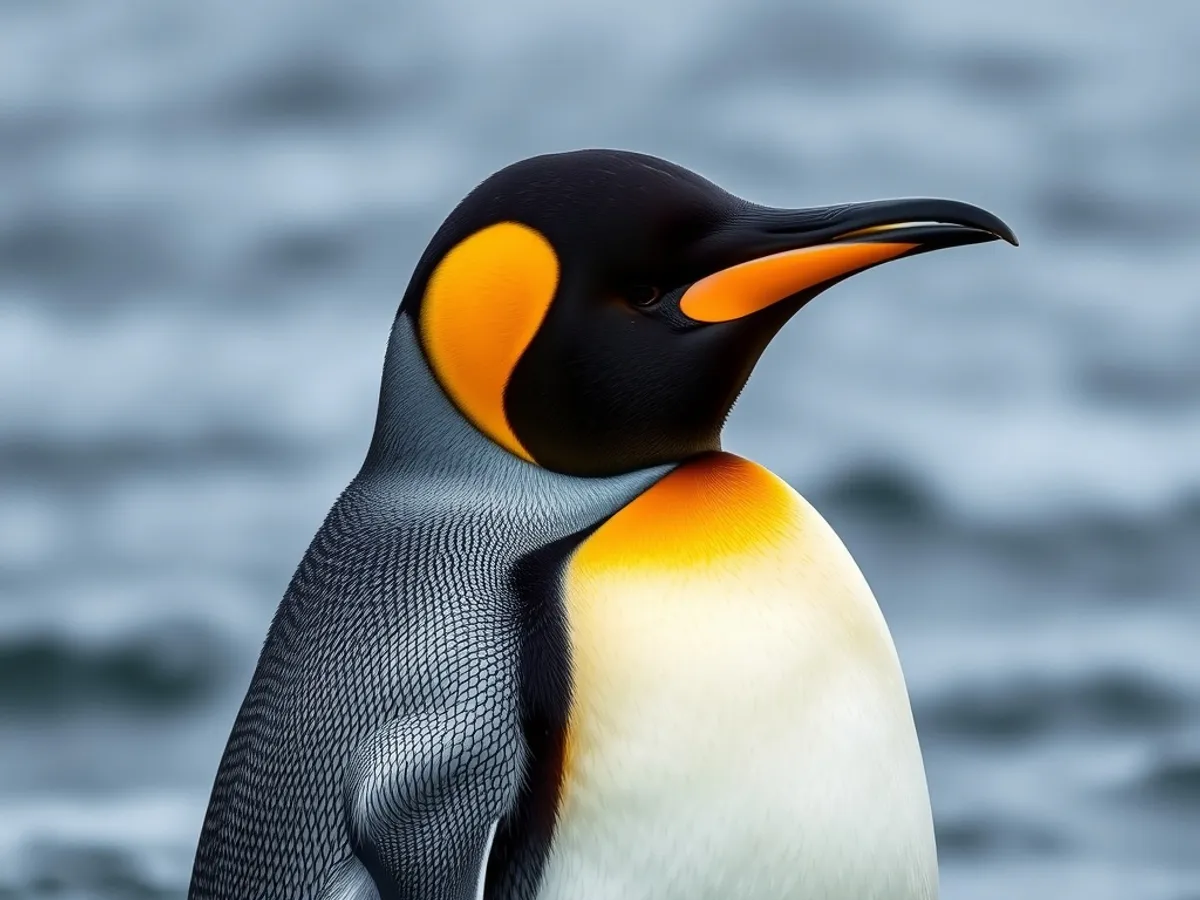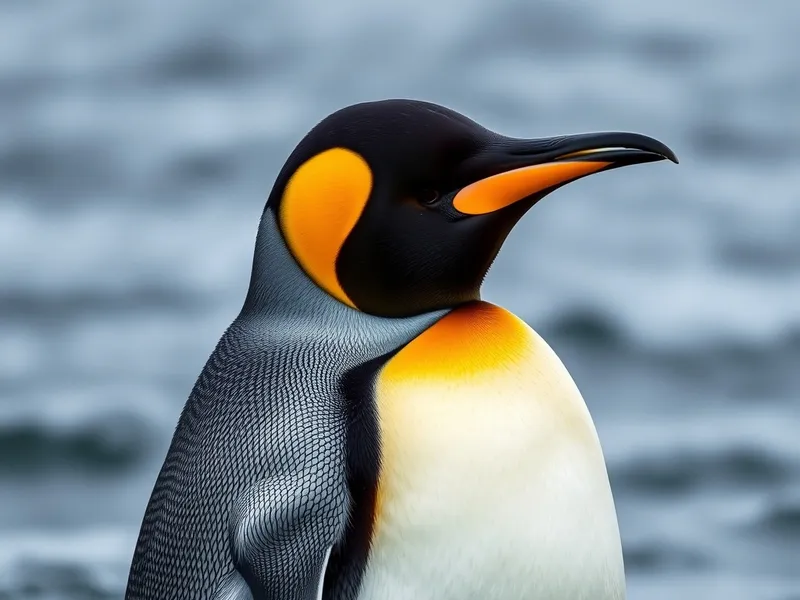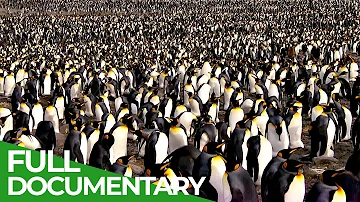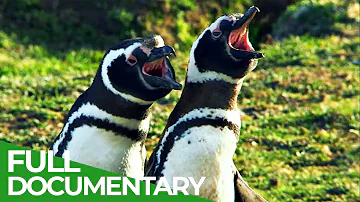
King Penguin
Aptenodytes patagonicus

Meet the King Penguin
The King Penguin is the second largest species of penguin, distinguished by its striking orange-yellow patches on the side of its head and upper chest. Highly adapted to cold environments, it breeds on subantarctic islands with large colonies numbering in the thousands. King Penguins are expert swimmers, capable of diving to depths over 300 meters in search of fish and squid. Their unique breeding cycle lasts more than a year, with parents taking turns incubating a single egg on their feet.
Classification
Bird
Habitat
Subantarctic islands and surrounding cold ocean waters
Diet
Carnivore
Lifespan
15-20 years
Conservation
Least Concern
Weight
11-16 kg
📖Fascinating Facts
Second Largest Penguin
King Penguins are only surpassed in size by the Emperor Penguin, making them the second largest penguin species in the world.
Unique Incubation
Instead of building nests, King Penguins incubate their single egg on their feet, covered by a brood pouch for warmth and protection.
Deep Divers
They are capable of diving over 300 meters deep and can spend up to 5 minutes underwater while hunting for prey.
📋Detailed Description
The King Penguin (Aptenodytes patagonicus) is a strikingly large and elegant seabird, reaching heights of 85–100 cm (33–39 in) and weighing between 9.3 and 18 kg (20–40 lbs), with males and females similar in appearance. Its plumage features a silvery-grey back, black head, and vivid orange-yellow patches on the sides of the head and upper chest, which intensify with age. The bill is long and slender, with a pinkish-orange lower mandible. King Penguins possess a streamlined body and strong, flipper-like wings adapted for efficient underwater propulsion. Their dense, layered feathers and thick subcutaneous fat provide insulation against frigid subantarctic waters. Social by nature, King Penguins form densely packed colonies that can number in the hundreds of thousands, exhibiting complex vocal and visual communication. They are highly specialized divers, capable of reaching depths over 300 meters (980 ft) and remaining submerged for up to 9 minutes while pursuing prey. Unlike most birds, their breeding cycle spans more than a year, with a single egg incubated alternately by both parents on their feet, protected by a brood pouch. Chicks are reared in communal crèches, allowing adults to forage at sea for extended periods. King Penguins are long-lived, with average lifespans of 15–20 years in the wild, and exhibit strong site fidelity, often returning to the same breeding grounds year after year.
💡 Did you know?
Unlike most birds, King Penguin chicks take over a year to fledge and are cared for by their parents through the harsh winter.
🔬Research & Sources
Wikipedia Summary
The king penguin is the second largest species of penguin, smaller than but somewhat similar in appearance to the emperor penguin.
Last Modified: 4/20/2025
🎭Behavior & Social Structure
King Penguins are diurnal and highly social, spending much of their lives in large, noisy colonies on subantarctic islands. Their daily activities include preening, vocalizing, and engaging in complex courtship or territorial displays. Foraging trips can last from a few days to several weeks, depending on chick-rearing stage and prey availability. They primarily hunt myctophid fish (lanternfish), squid, and occasionally crustaceans, employing pursuit-diving techniques and using their excellent underwater vision to locate prey. King Penguins are known for their remarkable swimming speed, reaching up to 12 km/h (7.5 mph) underwater. On land, they move with a characteristic upright waddle and may toboggan (slide on their bellies) over snow. Social interactions are mediated by a variety of calls and postures, with individual vocalizations allowing mates and chicks to recognize each other among thousands. Aggressive encounters, though rare, involve bill fencing and vocal threats, especially during territory defense or chick protection.
👶Reproduction & Life Cycle
King Penguins have a unique protracted breeding cycle, lasting approximately 13–16 months from egg laying to fledging. Breeding occurs in large colonies, with courtship beginning in late autumn or early winter. Pairs form monogamous bonds for the season, engaging in elaborate mutual displays. Females lay a single, large egg (weighing about 300 g) which is incubated on the parents' feet, covered by a brood pouch. Incubation lasts 54–58 days, with parents alternating shifts of 6–18 days. After hatching, the chick remains on the parent's feet for warmth and protection for 30–40 days, then joins a crèche with other chicks. Both parents continue to feed the chick by regurgitation. Fledging occurs at 10–13 months, with chicks enduring a fasting period during the winter when parents are at sea. Due to the extended cycle, King Penguins typically breed twice every three years, rather than annually.
🛡️Adaptations & Survival
King Penguins exhibit several remarkable adaptations for life in cold, marine environments. Their dense, waterproof plumage and a thick layer of blubber provide insulation against temperatures that can drop below freezing. The counter-shaded coloration (dark back, light belly) offers camouflage from predators both above and below water. Their hemoglobin has a high affinity for oxygen, allowing prolonged dives, while their muscles contain large amounts of myoglobin for oxygen storage. Specialized salt glands above the eyes excrete excess salt from ingested seawater. Behavioral adaptations include communal chick-rearing (crèching) for thermoregulation and predator avoidance, as well as synchronized breeding to maximize chick survival. Their vocalizations are uniquely structured, with individual-specific frequency signatures enabling parent-chick recognition in dense colonies.
🎨Cultural Significance
King Penguins have long fascinated explorers, naturalists, and the public, often symbolizing the remote and pristine nature of the subantarctic. They feature prominently in wildlife documentaries, ecotourism, and conservation campaigns. In some indigenous cultures of the subantarctic, penguins were historically a source of food and oil, though King Penguins were less targeted than smaller species. Today, they are protected by international agreements, and their charismatic appearance makes them a flagship species for polar conservation efforts. Their image is widely used in art, literature, and media to evoke themes of endurance, fidelity, and adaptation.
🔬Recent Research & Discoveries
Recent research has focused on the effects of climate change on King Penguin foraging ranges and breeding success, revealing that warming waters may force colonies to relocate or face reduced chick survival. Satellite tracking and bio-logging have provided detailed insights into their at-sea movements and diving physiology. Genetic studies indicate low differentiation between subspecies, suggesting recent expansion and high gene flow. Studies of their vocal communication have advanced understanding of individual recognition mechanisms in dense colonies. Ongoing research is monitoring population trends, disease prevalence, and the impact of fisheries on prey availability. King Penguins are also used as bioindicators for the health of subantarctic marine ecosystems.
🎥Wildlife Videos

Wildlife - Just Penguins | Free Documentary Nature
Wildlife - Episode 2: Just Penguins | Wildlife Documentary Watch 'Wildlife - Episode 3' here: https://youtu.be/eiqeZwk7NhI This ...
Free Documentary - Nature

South Georgia - Penguin Paradise of the South Atlantic | Free Documentary Nature
In the middle of the Antarctic Ocean, an entire mountain range arises from the water: South Georgia, the nursery of the Antarctic.
Free Documentary - Nature

Wildest Islands | Falkland Islands - Penguin Paradise | Free Documentary Nature
Wildest Islands - Episode 5: Falkland Islands - Penguin Paradise | Wildlife Documentary Watch 'Wildest Islands - Episode 1' here: ...
Free Documentary - Nature

Best Penguin Moments | BBC Earth
Living in some of the coldest, harshest conditions on Earth means that every day is a struggle to survive. From facing off against ...
BBC Earth

Go Inside an Antarctic 'City' of 400,000 King Penguins — Ep. 4 | Wildlife: Resurrection Island
#NationalGeographic #BertieGregory #WildlifeResurrectionIsland Read more about “Wild_Life: Resurrection Island” here: ...
National Geographic

Penguins Go MONTHS Without Feeding! | Wild Bites | BBC Earth Kids
Wild Bites is a fun, fact-packed blast of everything you need to know about some of the world's most amazing animals, with ...
BBC Earth Kids
🌍Habitat Information
The King Penguin typically inhabits Subantarctic islands and surrounding cold ocean waters environments. King Penguins have adapted to their environments with specialized features and behaviors.
Primary Habitat:
Subantarctic islands and surrounding cold ocean waters
More detailed habitat information will be available soon.
🛡️Conservation Status
The King Penguin is currently classified as Least Concern. Conservation efforts are crucial for preserving this species for future generations.
Common Threats:
- 🏠Habitat loss and fragmentation
- 🌡️Climate change impacts
- 🎯Hunting and poaching
- 🏭Human-wildlife conflict
⚠️Threats & Conservation Challenges
Currently classified as Least Concern by the IUCN, King Penguins face several emerging threats. Climate change is altering ocean temperatures and prey distribution, potentially reducing food availability and breeding success. Overfishing of key prey species (especially myctophid fish) poses additional risks. Human disturbance, oil spills, and introduced predators (such as rats and cats on some islands) can impact colonies. Disease outbreaks and pollution (including microplastics) are growing concerns. While global populations are estimated at over 2 million breeding pairs and are generally stable, some colonies have shown declines linked to environmental variability and anthropogenic pressures.
🔬Scientific Classification
Scientific Name
Aptenodytes patagonicus
Classification Hierarchy
🔍 About Taxonomic Classification
Taxonomic classification is a hierarchical system used by scientists to classify and organize living organisms based on shared characteristics and evolutionary relationships.
The system moves from broad categories (Kingdom) to increasingly specific ones, with each animal's scientific name typically consisting of its Genus and species.
📝Community Notes
Share your observations and insights about the King Penguin with our community of wildlife enthusiasts.
Join Our Community
Sign in to share your observations and connect with fellow wildlife enthusiasts.
Sign In to ContributeNo community notes yet
Be the first to share your observations about the King Penguin!
Explore King Penguin
Select a tab above to learn more about this amazing animal.
📸Photo Gallery
No photos available for this animal yet.
🌟Discover More Wildlife
Continue your journey of discovery with more fascinating animals from our database
